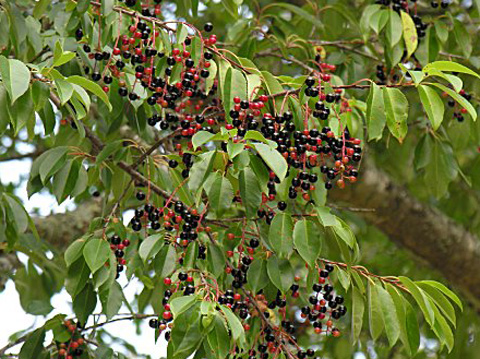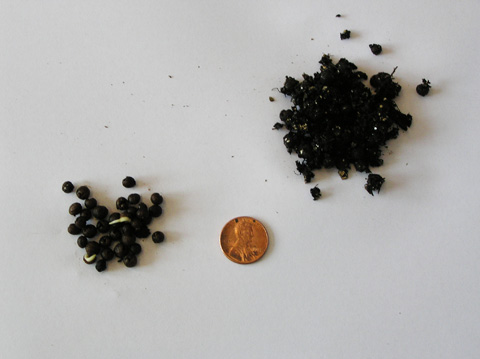 |
| Home | Ordering By Mail | Purchase Manual: Using Native Plants in Urban Landscapes |
|
|||||
Species Name: Prunus serotina
Common Name: Black Cherry
Zone: 4 to 9
Distribution: Nova Scotia to Minnesota in the north, south to Florida and Texas
Seed collection: Begin collecting seed in September through October. Plants growing in full sun will produce the most fruit. Seek out trees growing in hedgerows, forest margins or old-fields, as these will produce more fruit and have low hanging branches that will enable easier harvest. Seed should be collected soon after it ripens. Seed is mature and ready for collecting when the fruit changes color. Fruit will go through a series of color changes from green to bright red and then gradually turning a deep purplish black.
Seed is readily eaten by most songbirds. Many small to large mammals from black bear to raccoons, possum and fox relish black cherry fruit. Fruit is either eaten directly from the tree or off the ground after the fruit has fallen. Most fruit will be consumed and seed dispersed in just a couple of weeks. Some fruit may persist on the tree for a few weeks to a month longer, the fruit shriveling on the twigs. Animals function as the primary seed dispersal agents for cherry, when they eat the fruits and regurgitate it or excrete the seed in their feces. Fallen seed and seed dispersed by birds and mammals is subject to high seed predation by mice and chipmunks.
Seed handling: The fruit of Black cherry (BC) consists of a small hard pit surrounded by a fleshy pulp. The pulp and skin should be removed from the seed soon after collection or the fruit will begin to ferment and decay. The pulp and skins are easily removed from the seed by macerating the fruit with your hands. Large batches can be macerated using a food processor. Blend until the skins and pulp are pureed. Processing will not damage the hard pits. Separate the pulp and skins from the seeds by floating off the waste. Sound seeds will sink to the bottom of the container and aborted seed, skins and pulp can be poured off with several changes of water until only sound seed remains.
Seed can either be planted immediately or placed in a moist potting mix for stratification. Seed should not be stored dry. Two to three months of cold/moist stratification is usually sufficient to overcome embryo dormancy. Seed can be fall planted or spring seeded into prepared seedbeds. Seed can also be direct sown in the ground in natural soil. If you have a large quantity of seed and limited time for hand planting, you can simply hand broadcast seed over the area to be planted. This is better than not planting the seed at all.
Stratified seed often begins to germinate in storage prior to planting. Germinating seed can be planted in individual pots or in seedbeds but make sure the emerging root is pointing down.
Germination requirements: Close to 100% of cleaned seed will be viable. A very high percentage of seed will germinate the first spring if cold/moist stratified for 2 to 3 months or fall planted. A percentage of seed that does not germinate the first spring will germinate the following year or occasionally even later. Sow seed ¼ to ½” deep in prepared seedbeds or in native soils. Seedlings will grow from a few inches to 6 to 12” maximum the first year depending on weed competition and growing conditions. Seedlings require part shade the first year. Artificial shade can be provided for the seedbeds or seed can be planted where natural cover will provide the shade. In native plantings place seed in contact with the soil where there is minimal competition from weeds. Seedlings can effectively compete with some weeds under natural conditions.
Ecology: Black cherry is a valuable commercial timber species as well as being an important wildlife species. Black cherry lumber brings the highest price of any of the hardwood species with the exception of Black walnut. It is used for veneer, fine cabinetry, furniture and trim. Black cherry reaches its greatest size on deep rich moist soils with a pH of 6 to 7. It commonly grows on many poorer quality sites such as dry gravelly ridges or those with shallow soils but seldom achieves its full timber potential. Cherry is seldom a dominant species of any forest community but usually consists of a minor component. On good sites it is associated with White ash, Yellow birch, Basswood and Hickory.
Black cherry is shade intolerant and seldom regenerates under a mature tree canopy. Cherry seedlings establish and grow best in old-field vegetation or young to medium aged woodland with an open canopy. Cherry will also establish in forest openings caused by wind throw or logging activity. Old field and second growth woodland provides enough sunlight for rapid seedling development. Black cherry will out grow most of the associated tree species. Trees that establish with moderate competition produce straight defect free logs that have the best saw timber potential. Cherry will race for the available sunlight, growing tall and straight with few lateral branches.
Black cherry should be widely planted because of its high wildlife value. It produces large quantities of fruit that is eaten by most wildlife. Deer and rabbits prefer cherry and readily browse seedlings and young shoots. Their feeding can retard or even eliminate seedling survival and cherry recruitment when their populations are too high. Black cherry also supports large numbers of insect herbivores and a great diversity of insect species; converting cherry leaves into insect protein thereby providing food for numerous song birds. According to Douglas Tallamy in (Bringing Nature Home), prunus species supports 456 lepidoptera species alone, not to mention all of the other orders of insects.

Cherry seed ready for harvest.

Cherry seed beginning germination during stratification.
this page posted February 5th, 2011